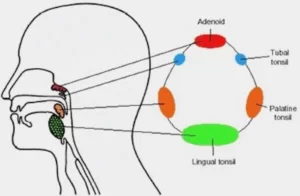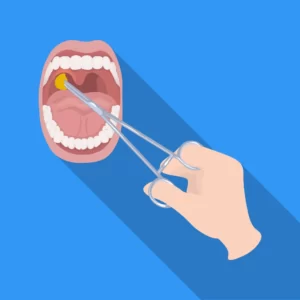
Medically Reviewed By:
Dr Leslie Koh M.B;B.S. (Singapore), MRCS (ENT) Edinburgh, M. Med (ORL), FAMS
Understanding Tonsillectomy
 Tonsillectomy, the surgical removal of the tonsils, has been practiced for over 2,000 years. The tonsils are two small masses of lymphoid tissue situated at the back of the throat, playing a crucial role in the body’s immune system. Over time, the procedure has evolved, with various techniques being developed to ensure a safer and more effective operation.
Tonsillectomy, the surgical removal of the tonsils, has been practiced for over 2,000 years. The tonsils are two small masses of lymphoid tissue situated at the back of the throat, playing a crucial role in the body’s immune system. Over time, the procedure has evolved, with various techniques being developed to ensure a safer and more effective operation.
Definition and Purpose of Tonsillectomy
Tonsillectomy is primarily performed to treat chronic or recurrent tonsillitis, obstructive sleep apnea, and other tonsil-related issues. The goal is to alleviate symptoms, improve the quality of life, and prevent potential complications.
Historical Background
The procedure has a rich history, with some of the earliest recordings dating back to the Roman Empire. However, it became more prevalent and safer with the advent of modern surgical techniques and anesthesia in the 19th century.
The Anatomy Of The Tonsils
The tonsils are a crucial part of the lymphatic and immune systems, located in the throat area. This is a detailed explanation of their anatomy:

Location:
- The tonsils are situated near the back of the throat, just behind the soft palate. There are two tonsils, one on each side of the throat.
Structural Composition:
- Tonsils are made up of lymphoid tissue, similar to lymph nodes, and are covered by pink mucosa. They are a type of mucosa-associated lymphoid tissue (MALT) which surround the opening of the nasal and oral cavities, containing aggregations of lymphoid nodules spread through the mucosal lining of the pharynx.
Types of Tonsils:
- The tonsillar system, also known as Waldeyer’s tonsillar ring, consists of several groups of tonsils:
- Palatine Tonsils: These are the most commonly referred tonsils, located at the rear of the throat (pharynx).
- Adenoid Tonsil (adenoids): Located at the back of the nasal cavity.
- Tubal Tonsils: These are situated around the openings of the Eustachian tubes.
- Lingual Tonsils: These are found at the base of the tongue.
- The tonsillar system, also known as Waldeyer’s tonsillar ring, consists of several groups of tonsils:
Cellular Composition:
- Tonsils contain various immune cells, including T cells, B cells, and macrophages, which play a significant role in fighting infections. They serve as the first line of defense against pathogens entering through the nasopharynx or oropharynx.
Function:
- The tonsils play an essential role in the immune system, helping to protect the body against respiratory and gastrointestinal infections. They act as a first line of defense by trapping and filtering airborne pathogens.
The anatomy of the tonsils allows them to effectively serve as a sentinel, guarding against harmful pathogens that might enter the body through the oral or nasal passages. They are a critical part of the body’s immune response, although tonsil removal (tonsillectomy) may be necessary in cases of recurrent infections or other medical conditions affecting the throat area.
When Is Tonsillectomy Recommended?
 A tonsillectomy can significantly improve a person’s quality of life, especially those suffering from chronic tonsillitis or sleep apnea. However, like any surgical procedure, it requires thorough preparation. Tonsillectomy is typically recommended when tonsillitis or other tonsil issues become recurrent, or when they obstruct normal breathing or swallowing. Tonsil size can also be graded by a tonsil grading scale, which can ascertain the need for a tonsillectomy.
A tonsillectomy can significantly improve a person’s quality of life, especially those suffering from chronic tonsillitis or sleep apnea. However, like any surgical procedure, it requires thorough preparation. Tonsillectomy is typically recommended when tonsillitis or other tonsil issues become recurrent, or when they obstruct normal breathing or swallowing. Tonsil size can also be graded by a tonsil grading scale, which can ascertain the need for a tonsillectomy.
Preparing For A Tonsillectomy
The procedure of a tonsillectomy involves several steps, often beginning with a pre-surgery assessment to ensure patient safety, followed by the actual surgical process where the tonsils are removed, and then, post-operative care. Tonsillectomy generally refers to removal of the PALATINE TONSILS.
Pre-Procedure:
- Pre-Surgery: Before the surgery, patients may need to undergo various tests to ensure they are fit for the procedure. Concerns should also be discussed with the surgeon prior to surgery.
During the Procedure:
- Anesthesia: The surgery is performed under general anesthesia, hence the patient is unaware of the procedure and does not experience pain during the operation.
- Tonsil Removal: The surgeon may remove the tonsils using a scalpel or a specialized surgical tool that utilizes heat or high-energy heat or sound waves to eliminate or destroy tissues and manage bleeding. The method and techniques of tonsil removal is discussed in greater detail below.
Post-Procedure:
- Dietary Adjustments: Post-surgery, the patient is advised to start with clear liquids, progressing to soft foods for about 10 days before returning to a regular diet. Spicy, hot, and dry foods like chips and toast should be avoided as these may cause pain or precipitate bleeding.
Tonsillectomy (Tonsil Removal) Techniques
The latest techniques in tonsillectomy revolve around minimizing post-operative complications and enhancing recovery. Here’s an expanded explanation of the latest techniques:
Cold Techniques:
Cold Dissection Snare Method: This method is the traditional technique where the tonsils are removed using a scalpel. It’s known for less thermal injury to surrounding tissues but might have higher bleeding risks compared to other methods.
Blunt Dissection Method: Another variant of cold techniques where the tonsils are dissected out bluntly.
Hot Techniques:
Monopolar and Bipolar Diathermy Dissection: These techniques use electrical current to cut through tissues and cauterize blood vessels to minimize bleeding.
Electrocautery Tonsillectomy: It utilizes electrical energy to remove the tonsils and coagulate the blood vessels simultaneously.
Harmonic Scalpel: This device uses ultrasonic vibrations to cut tissues and seal blood vessels, which can potentially reduce post-operative pain and bleeding.
Other Techniques:
Cryo-Tonsillectomy: Utilizes extreme cold to remove the tonsils.
Guillotine Excision: An older method where a guillotine-like device is used to amputate the tonsils.
Sutter Radiofrequency Method: Uses radiofrequency energy to remove tonsils with minimal thermal damage to surrounding tissues.
Coblation Technique: This technique uses radiofrequency energy to dissolve tonsil tissue at relatively low temperatures, which might result in less postoperative pain.
Microdebrider Tonsillectomy: A powered rotary shaving device is used to remove tonsil tissue.
Intracapsular Tonsillectomy:
COBLATION Intracapsular Tonsillectomy (CIT): A newer technique shown to improve post-operative outcomes compared to traditional total tonsillectomy techniques.
Adaptations based on Patient and Surgeon Factors:
- Techniques may vary based on patient age, indication for surgery, surgeon’s experience, and available equipment. For instance, the emergence of sleep-disordered breathing and milder presentations of obstructive sleep apnea as indications for adenotonsillectomy has led to the adoption of new techniques and technologies.
Operative Time Considerations:
- Cold techniques might take longer but are usually cheaper, while hot techniques like electrocautery might be quicker but potentially more expensive due to equipment costs.
These techniques are developed or chosen based on various factors including the surgeon’s preference, the patient’s overall health condition, and to minimize complications such as bleeding, pain; and enhance quick recovery post-operation. The choice between ‘hot’ and ‘cold’ techniques, for instance, often comes down to a surgeon’s experience and comfort level with a particular method, as well as the specific circumstances of each patient
Video Of Tonsillectomy (Monopolar Electrocautery)
* Courtesy of Mayo Clinic
Recovery After Tonsil Removal
The recovery process after a tonsillectomy involves several stages and considerations, including managing pain, maintaining hydration, and gradually returning to normal dietary and physical activities. The considerations after tonsil removal are listed below:
Recovery Time:
- The typical recovery time for a tonsillectomy is about 10 days to 2 weeks, although this can vary depending on the individual’s health and the technique used for the tonsillectomy. For children, the recovery might be around 7-10 days, while adults may require approximately 2-3 weeks to recover fully.
Pain Management:
- Pain is a significant concern following a tonsillectomy, often lasting for 11 to 12 days post-surgery. This tends to peak at the 3rd/4th post-operative day. Effective pain management is crucial for a smooth recovery. Over-the-counter pain relievers or prescribed medications like non-steroidal anti-inflammatory drugs (NSAIDs) combined with paracetamol and certain opiates may be used, although with caution as certain pain relievers can potentially increase the risk of bleeding.
Hydration and Diet:
- Staying hydrated is a crucial aspect of recovery to prevent dehydration, which can worsen symptoms and delay healing. Initially, soft foods such as ice cream and jelly are recommended, gradually transitioning to other soft foods such as porridge, soups and noodles or as tolerated over about 10 days post-surgery.
Monitoring and Follow-Up:
- The initial follow-up appointment will be in a week, with subsequent follow-ups at 2 week intervals. Regular follow-up appointments will allow the surgeon to assess the healing process and address any complications or concerns.
Gradual Resumption of Activities:
- Gradually resuming normal activities as tolerated is part of the recovery process. It’s advisable to avoid strenuous activities and follow the surgeon’s recommendations regarding when it’s safe to return to school or work. Exercise or strenuous activities should be suspended for at least 2 weeks.
Full Recovery:
- Whilst the initial recovery occurs within weeks, complete healing generally takes up to 4-6 weeks.
The recovery process may vary from person to person based on their age, overall health, the surgical technique used, and the patient’s adherence to post-operative instructions.
Risks and Complications Of Tonsillectomy
Oral Injuries:
- Teeth, Lips, and Gums: During a tonsillectomy, there is a risk of injury to the teeth, lips, and gums. The instrument used to keep the mouth open during the operation sits on the teeth, which may cause damage especially to loose, capped, or crowned teeth. It’s essential to inform the surgeon and anaesthetist about any dental crowns, caps, or loose teeth before the anesthesia is administered.
- Tongue: There can be pressure applied to the tongue from the surgical retractor, which might lead to discomfort or injury post-surgery. There are also mentions of pain in the mouth and tongue post tonsillectomy which might be related to the surgical procedure itself or the healing process thereafter.
Taste Disturbances:
- Following tonsillectomy, some individuals experience disturbances in taste. This includes taste dysfunction which might be due to nerve damage during surgery. These disturbances can last for a few days to several months, and in rare cases, may be permanent. The chorda tympani nerve, which is responsible for carrying taste sensations from the anterior two-thirds of the tongue, might get damaged during surgery, leading to taste disturbances.
Perioral Burns:
- There’s a rare risk of perioral (around the mouth) burns during a tonsillectomy, especially when electrocautery devices are used. In a study over a 9-year period, 7 cases of perioral burns were noted among 4327 tonsillectomies/adenoidectomies, with a complication rate of 0.16%. In a survey involving numerous otolaryngologists, the incidence of perioral burns was estimated between 0.01% and 0.04%. These burns could range from minor to severe, with some resulting in scarring requiring further medical intervention such as steroid injections, stenting, or additional reconstructive procedures.
Reactions to Anesthetics:
- Medications used to induce sleep during surgery could cause minor, short-term issues like headaches, nausea, vomiting, or muscle soreness. Though severe long-term problems are rare, general anesthesia carries a minimal risk of death and may cause swelling post-operation.
Bleeding:
- Bleeding is a common complication following a tonsillectomy. The incisions made during surgery can lead to bleeding, with about 4% of children experiencing this complication. Bleeding occurs in about 1% of cases within the first day and another 2% after that. Excessive bleeding, either during or post-surgery, is a potential risk for up to 2 weeks after surgery.
Infection and Swelling:
- Post-surgical infection is a potential risk, as well as swelling of the tongue, uvula or the roof of the mouth.
Postoperative Pain and Bleeding:
- Severe postoperative pain, complicated by postoperative bleeding, can occur, which, in rare cases, might lead to death. This emphasizes the need for evidence-based guidelines to assist healthcare professionals in deciding when a tonsillectomy is indicated.
Life Without Tonsils
Living without tonsils may have its benefits and drawbacks, which vary from person to person. Living without tonsils after a tonsillectomy is a journey that begins with a healing phase, which generally lasts for about 10 to 14 days. During this period, individuals may experience pain, which can be managed with medications as prescribed. After recovery, life resumes with a notable reduction in throat infections, breathing, or sleeping issues that might have triggered the decision for a tonsillectomy.
Despite the potential risks, tonsillectomies continue to be a common solution for persistent issues like recurrent tonsillitis, with over 400,000 procedures performed annually in the European Union alone. The procedure’s potential to significantly alleviate or resolve recurrent throat infections and obstructive sleep apnea, particularly in children, is a strong motivator for its continued practice.
In conclusion, life without tonsils post-tonsillectomy offers immediate relief from the ailments that necessitated the surgery.
Long-term Benefits Of Tonsil Removal
Tonsillectomy, the surgical removal of the tonsils, is a common procedure often recommended for recurrent throat infections or obstructive sleep apnea. It offers immediate relief from such ailments, as follows:
Relief from Chronic Conditions:
- Individuals, especially children, who frequently suffer from severe throat infections or obstructive sleep apnea, find substantial relief post-tonsillectomy. The procedure can significantly reduce the occurrence of these issues, improving the overall quality of life.
Reduced Absenteeism:
- For school-going children, a significant reduction in throat infections means fewer missed school days, promoting better attendance and potentially better academic performance.
Better Sleep Quality:
- By alleviating obstructive sleep apnea, tonsillectomy can lead to better sleep quality which is crucial for physical and mental health.
Lessened Discomfort and Pain:
- Chronic tonsillitis can cause persistent discomfort and pain. Tonsillectomy provides a long-term solution, eliminating the constant sore throat discomfort.
Alternatives to Tonsillectomy
When considering alternatives to tonsillectomy, various options have emerged, each with its own set of advantages and considerations. Here are some alternatives:
Tonsillotomy:
- Tonsillotomy, a less invasive procedure compared to tonsillectomy, involves partial removal of tonsil tissue. This procedure has shown favorable outcomes in children, although its effectiveness in adults remains to be further elucidated.
- It has been used in some countries primarily to treat obstructive sleep apnea in young children, and more recently, to address recurrent acute tonsillitis as well.
Coblation Tonsillectomy:
- Coblation Tonsillectomy is an innovative procedure that allows for the removal of tonsils and adenoids with very little pain and a fast recovery.
- The term “coblation” is derived from “controlled ablation,” and the procedure removes or ablates tonsil tissue with minimal harm to surrounding healthy tissue. Unlike conventional electrosurgery and laser surgery that may char or burn healthy tissue, Coblation Tonsillectomy utilizes bipolar radiofrequency energy combined with a saline solution to gently and precisely remove tissue.
- The benefits include fewer ‘bad days’ post-surgery, faster recovery with patients returning to a normal diet in about 2.4 days (compared to 7.6 days with electrocautery), and less pain which translates to reduced use of pain medications post-procedure. This technology has been used in more than 4 million surgeries, and it’s considered an advanced alternative to traditional methods like scalpel or electrocautery which can cause extensive pain and may damage surrounding healthy tissue.
Herbal Alternatives:
- Herbal treatments, though less conventional, are sometimes explored. For instance, the herb Figwort is suggested as a herbal alternative, used in very small doses. However, the effectiveness and safety of such herbal alternatives haven’t been well-established in scientific literature, and it’s crucial to consult with healthcare providers before considering this route.
Medication:
- In some cases, antibiotics like Clindamycin have been used for the treatment of recurrent acute tonsillitis as an alternative to tonsillectomy.
These alternatives come with their own set of considerations and should be discussed in depth with your surgeon to ascertain the most suitable option for individual cases. Each alternative addresses different aspects of tonsil-related issues, and their appropriateness can vary based on the specific circumstances and the age and health of the individual.
Conclusion
Tonsillectomy is a common and generally safe procedure that can significantly improve the quality of life for individuals suffering from recurrent tonsillitis, sleep apnea, or other tonsil-related issues. However, like any surgery, it requires careful consideration and preparation.
Contact us for more information regarding your tonsillectomy today.
Frequently Asked Questions (FAQs)
What Is The Main Purpose Of A Tonsillectomy?
A tonsillectomy is performed primarily to treat recurring tonsillitis, obstructive sleep apnea, and other conditions related to the tonsils. The procedure aims to alleviate symptoms, enhance the quality of life, and prevent potential complications such as breathing obstructions or infections spreading to surrounding tissues.
How Long Does It Take To Recover From A Tonsillectomy?
Recovery time can vary from person to person. Typically, it takes about 1 to 2 weeks for individuals to recover sufficiently to return to their normal activities. However, complete healing might take a bit longer, possibly up to a month. It’s essential to follow post-operative instructions diligently to ensure a smooth recovery.
What Are The Risks Associated With Tonsillectomy?
Like any surgical procedure, tonsillectomy carries certain risks. These may include bleeding, infection, adverse reactions to anesthesia, and complications associated with breathing or swallowing. It’s crucial to have a thorough discussion with your surgeon about the potential risks and benefits of the procedure.
Are There Alternatives To Tonsillectomy?
Yes, there are alternatives to tonsillectomy. Depending on the underlying condition, treatments such as antibiotics for infection, lifestyle changes for sleep apnea, or other medical therapies might be suitable alternatives.
What Is The Long-Term Outlook For Individuals Who Have Had A Tonsillectomy?
The long-term outlook for individuals post-tonsillectomy is generally positive. Many people experience a significant reduction in the frequency and severity of throat infections, improved sleep quality, and a better overall quality of life. However, the specific outcomes can vary, and it’s best to discuss long-term expectations with your healthcare provider.
Disclaimer:
The information, including but not limited to, text, graphics, images and other material contained on this website are for informational purposes only. No material on this site is intended to be a substitute for professional medical advice, diagnosis or treatment. Always seek the advice of your doctor or other qualified health care provider with any questions you may have regarding a medical condition, treatment or medication and before undertaking a new health care regimen, and never disregard professional medical advice or delay in seeking it because of something you have read on this website. If you think you may have a medical emergency, call 995 or visit the nearest Emergency Department immediately. No doctor-patient relationship is created by this website or its use. Neither the owner of the website, nor its employees, or any contributor to this web site, makes any representations, express or implied, with respect to the information provided herein or to its use.








